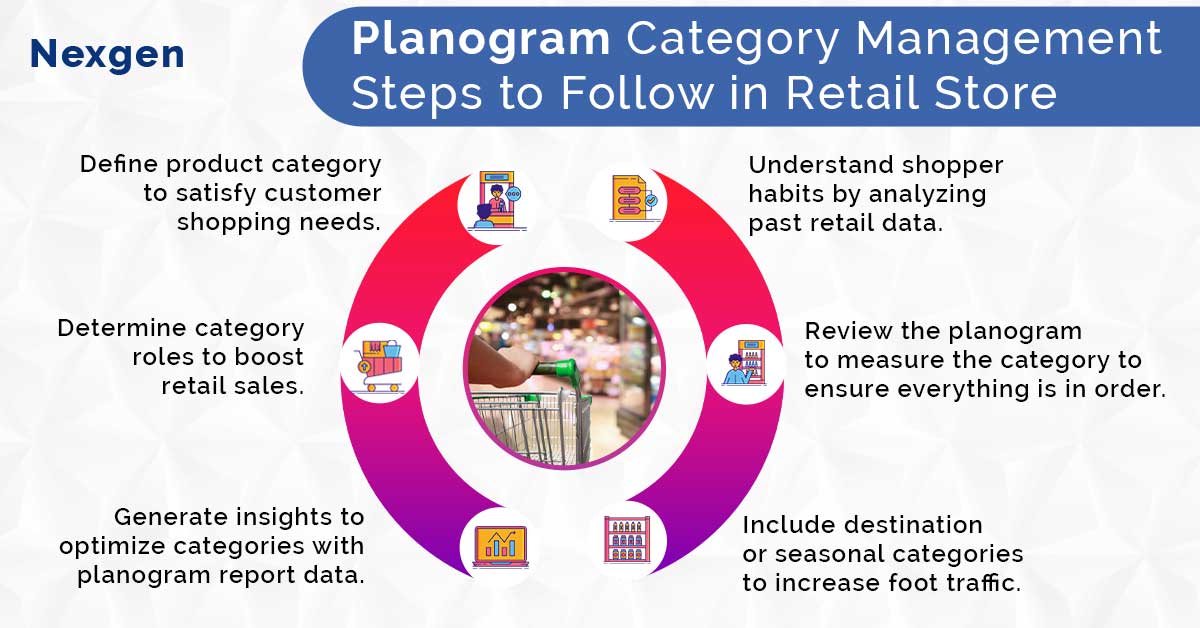The shopping experience you give to your shoppers can influence their attitude and perception of your store. It can, in turn, have a direct effect on the profit and ROI of your store. That is why category management plays a significant role in creating an enticing shopping experience that your customers will enjoy.
Let us say that, you know category management is worth doing. But what about the process as a whole? How do you implement category management in your retail business? The answer is simple: you can give the customer the products they want, when they want them at a price that fits their needs by using planogram software. Planograms are visual merchandising tools, which identify products for the target segment and help understand how the customer encounters those products on the store shelves to encourage them to purchase. More importantly, this ensures the right balance in stocking various category-wise products on shelves. So, the following are six planogram steps you need to follow in order to boost your sales:

- Define your categories: The first step in the category management process is to define your product category. As a retailer, you need to figure out your customer's needs and look at how they perceive a particular category to satisfy their shopping needs. It is important to define the category, since it helps you divide your products into different categories and helps in developing the consumer decision tree. For example, when deciding to purchase a cold beverage, your shopper will look into factors like price, packaging, flavor, size, or whether they want a carbonated or non-carbonated drink? Sometimes, it will be more challenging when there is a change in consumer behavior and demand, or when you have two different shoppers. For instance, Customer A is driven by convenience and functionality. Meanwhile, Customer B prefers shopping for expensive brands that offer better quality. Either way, you need to satisfy both customer’s needs by placing items of their individual preferences.
- Determine category roles: Once you have defined the category, it is important to determine its role. The category role you select determines your sales growth. Consumer-based category roles like destination, preferred/routine, occasion/season, and convenience can help you determine the category well. This helps you satisfy your customer’s shopping needs and boost your sales.
- Generate insights to optimize categories: The third step in the category management process is insight generation, which relies on planogram sales data, analytical reports, customer research, and in-depth analysis. After going through these insights, you can understand the buying behavior of your shoppers. This way, you can find out if they are more loyal to certain brands or if they are convenient shoppers. This will help you know and understand how they perceive a category, or group into sub-categories and segments concerning your sales, profits, and store performance. During such time, you can also look at the opportunities to improve your category, product assortment, pricing, merchandising, and promotion.
- Remember and understand your shopper: As you start grouping the category roles, do not forget your shopper. They need to be included in every step along the way in your category management process. You need to understand who your target shopper is, and what their needs and priorities are while creating the category. The most important categories like ‘destination categories’ should have a higher priority – because they are the ones that draw customer attention to your store. This will help improve your store’s category management approach and boost sales.
- Set the objectives and tactics to deliver your goals: Choosing the strategy and tactics can optimize your gains. For that reason, you can generate traffic to your store by including destination or seasonal categories to get your shoppers into the store to buy more. You can always stock the top-performing SKUs or run promotions, bundle products or even cross-merchandise in high-traffic areas to increase sales. Also, placing seasonal categories or new and innovative items could generate excitement in customer’s minds and increase the chances of impulse purchases.
- Implement and review your category: This is the last step in the category management process. To get it right, you need to ensure that everything is in order. That includes ensuring the planograms have the right product list, fixtures, the right images, and all other activities. Also, you can review the planogram to measure the performance of your category, make changes if you need and monitor your category to move forward.
Overview of Nexgen POG
Nexgen POG is a robust and user-friendly cloud-based visual merchandising tool. It is designed for quick and efficient planogramming with minimal effort. Planograms can be designed by easily dragging and dropping the products. The multi-device compatibility feature of POG allows you to obtain, share and edit planograms on any device, including your phone. It helps in designing store-specific planograms for increased product visibility and sales.
Get Your Free Trial Now!